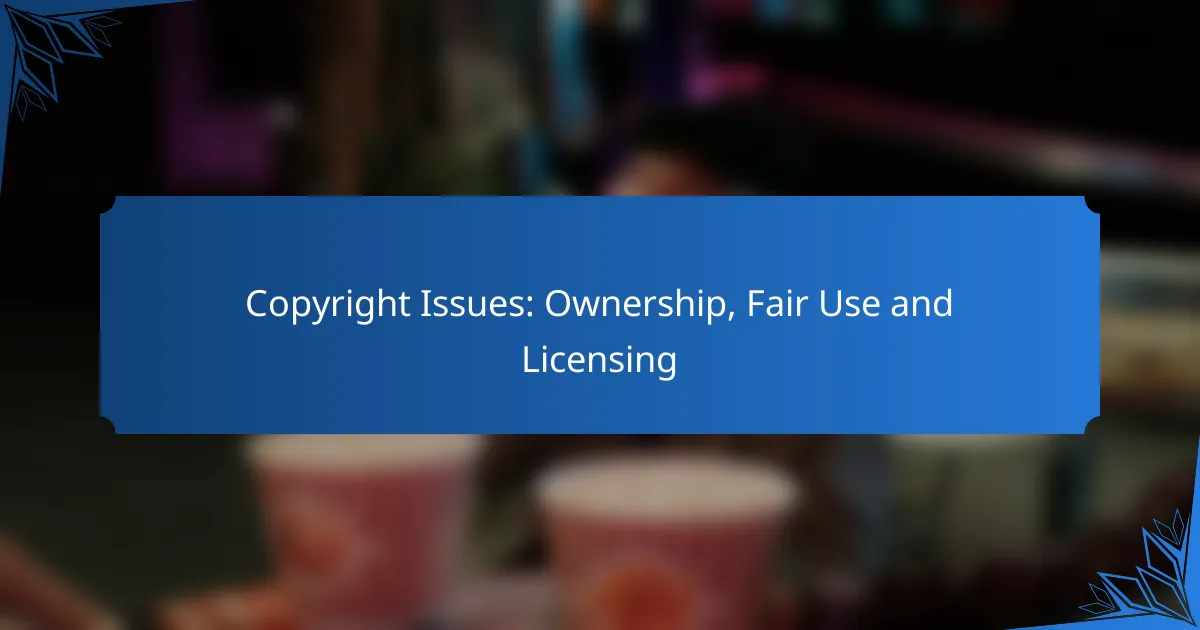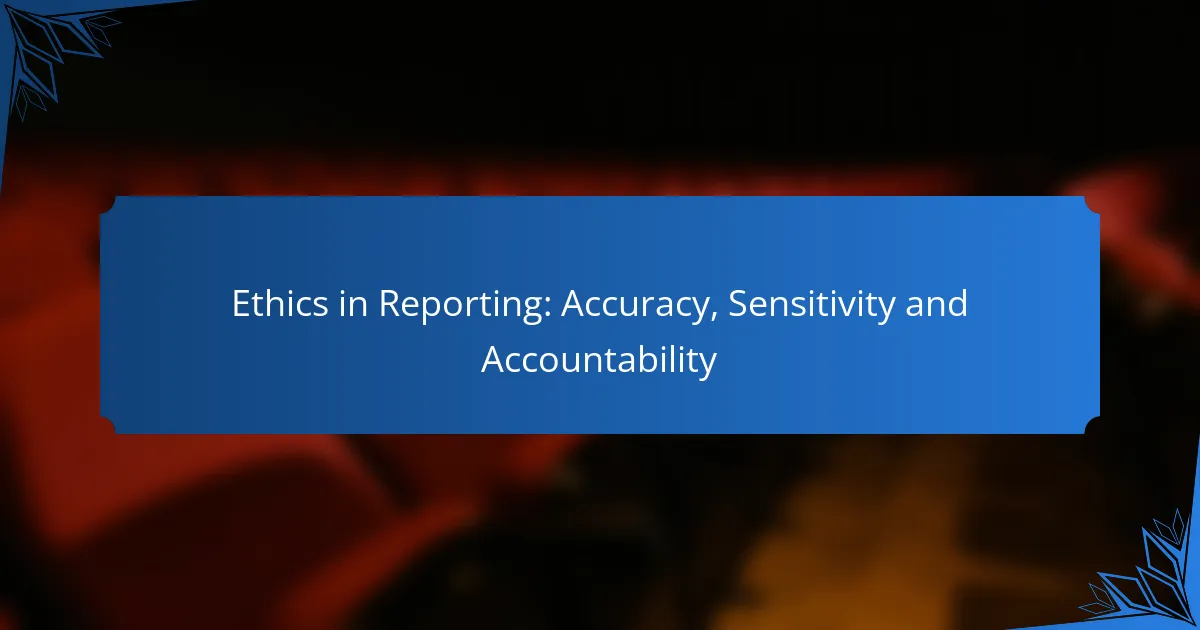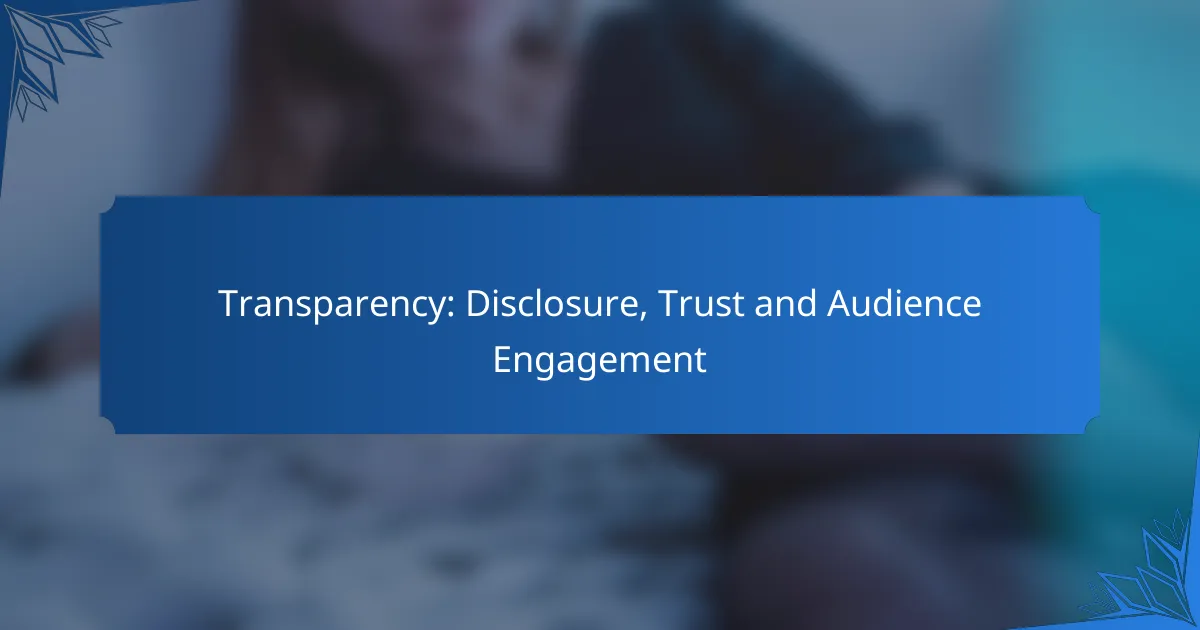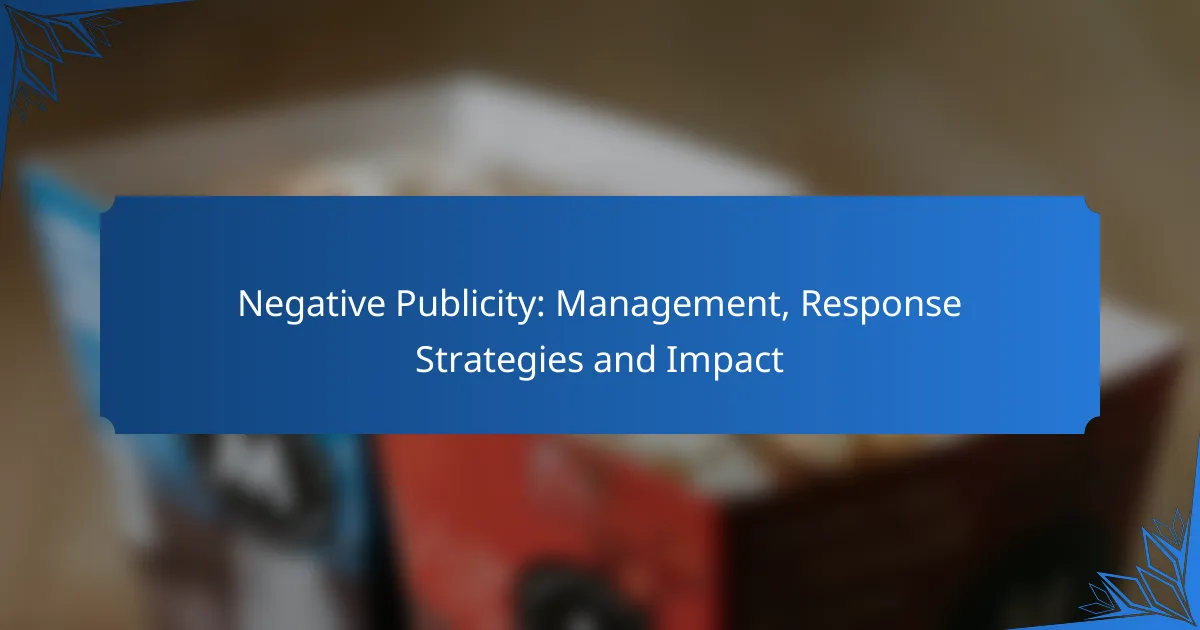Copyright issues encompass the complexities of ownership, fair use, and licensing of creative works. Understanding who holds the rights to a work and how those rights can be shared is essential for creators and businesses alike. Fair use provides a framework for limited use of copyrighted material without permission, while licensing options allow creators to dictate how their works are utilized. Navigating these aspects is vital to protecting intellectual property and minimizing legal conflicts.

What are the copyright ownership issues in the US?
Copyright ownership issues in the US revolve around who holds the rights to a creative work, how those rights can be shared, and the implications of employment on ownership. Understanding these issues is crucial for creators and businesses to protect their intellectual property and avoid legal disputes.
Individual ownership
Individual ownership occurs when a single person creates a work and retains all rights to it. This is common among independent artists, writers, and musicians who produce original content. The owner can control how the work is used, reproduced, and distributed, allowing for potential monetization through sales or licensing.
However, individual owners should be aware of the need to register their copyright with the U.S. Copyright Office to strengthen their legal standing in case of infringement. Registration provides a public record and can be necessary for pursuing legal action.
Joint ownership
Joint ownership arises when two or more individuals collaborate to create a work, sharing rights and responsibilities. Each co-owner has equal rights to use and license the work, but this can lead to complications if one owner wants to exploit the work commercially without the others’ consent.
To avoid disputes, it is advisable for joint owners to draft a written agreement outlining each party’s rights, responsibilities, and how profits will be shared. This agreement can help clarify expectations and prevent misunderstandings down the line.
Work for hire
Work for hire refers to creations made by an employee within the scope of their employment or works commissioned under specific agreements. In these cases, the employer or commissioning party automatically owns the copyright, not the creator. This arrangement is common in corporate environments and freelance contracts.
Creators should ensure that work-for-hire agreements are clearly defined and documented to avoid losing rights to their creations. Understanding the terms of employment or commission is essential, as it can significantly impact ownership and potential revenue from the work.

How does fair use apply to copyright?
Fair use allows limited use of copyrighted material without permission from the rights holder, primarily for purposes like criticism, comment, news reporting, teaching, scholarship, or research. The application of fair use is determined by a set of factors that assess the purpose, nature, amount, and effect of the use on the market value of the original work.
Transformative use
Transformative use refers to how much a new work adds to or changes the original material. If the new work provides new expression, meaning, or message, it is more likely to be considered fair use. For example, a parody that comments on the original work can qualify as transformative.
When evaluating transformative use, courts look at whether the new work alters the original with new insights or understandings. Simply reproducing the original without significant alteration generally does not meet this criterion.
Commercial vs. educational use
Commercial use typically weighs against fair use, as it may compete with the original work in the marketplace. However, educational use is often favored, especially when the material is used in a classroom or for non-profit purposes. For instance, a teacher using a short excerpt from a book for a lesson may be seen as fair use.
It’s crucial to consider the context of the use. If the educational use is for a non-commercial purpose and does not significantly affect the market for the original, it stands a better chance of being deemed fair use.
Amount and substantiality
The amount and substantiality factor assesses how much of the original work is used and the significance of that portion. Using a small excerpt may favor fair use, while using the “heart” of the work could weigh against it. For example, quoting a few lines from a song may be acceptable, but using the entire chorus might not be.
Courts often consider both the quantity and quality of the material used. Even a small amount can be too much if it constitutes the essence of the original work, so careful consideration is necessary when determining fair use based on this factor.
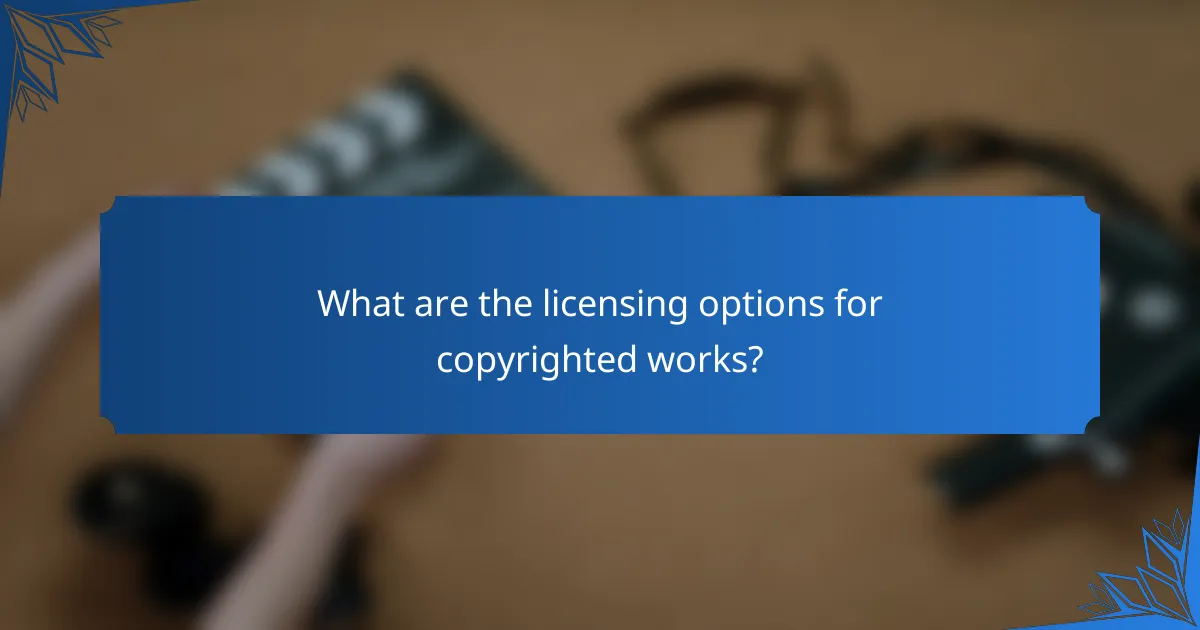
What are the licensing options for copyrighted works?
Copyrighted works can be licensed in several ways, allowing creators to control how their works are used. The main options include exclusive licensing, non-exclusive licensing, and Creative Commons licenses, each offering different rights and restrictions.
Exclusive licensing
Exclusive licensing grants one party the sole rights to use a copyrighted work, meaning the creator cannot license it to anyone else. This type of license often involves a higher fee and can be beneficial for both parties, as it provides certainty and potential for greater investment in the work.
When considering exclusive licensing, it’s essential to clearly define the scope, duration, and territory of the license. For example, a musician may grant an exclusive license to a record label for a specific album in a particular country, ensuring no other label can distribute that album in that region.
Non-exclusive licensing
Non-exclusive licensing allows multiple parties to use the same copyrighted work simultaneously. This option is often more affordable and flexible, making it suitable for creators who want to reach a broader audience without limiting their rights.
For instance, a photographer might offer non-exclusive licenses for their images to various websites, enabling multiple platforms to use the same photos while still retaining ownership. It’s crucial to specify usage rights and any limitations to avoid conflicts.
Creative Commons licenses
Creative Commons licenses provide a standardized way for creators to grant permissions for their works while retaining some rights. These licenses range from allowing any use with attribution to restricting commercial use or derivative works.
Using Creative Commons licenses can enhance visibility and sharing of works, especially online. For example, a writer might choose a CC BY license, permitting others to share and adapt their work as long as they give appropriate credit. Understanding the specific terms of each license is vital to ensure compliance and protect the creator’s interests.
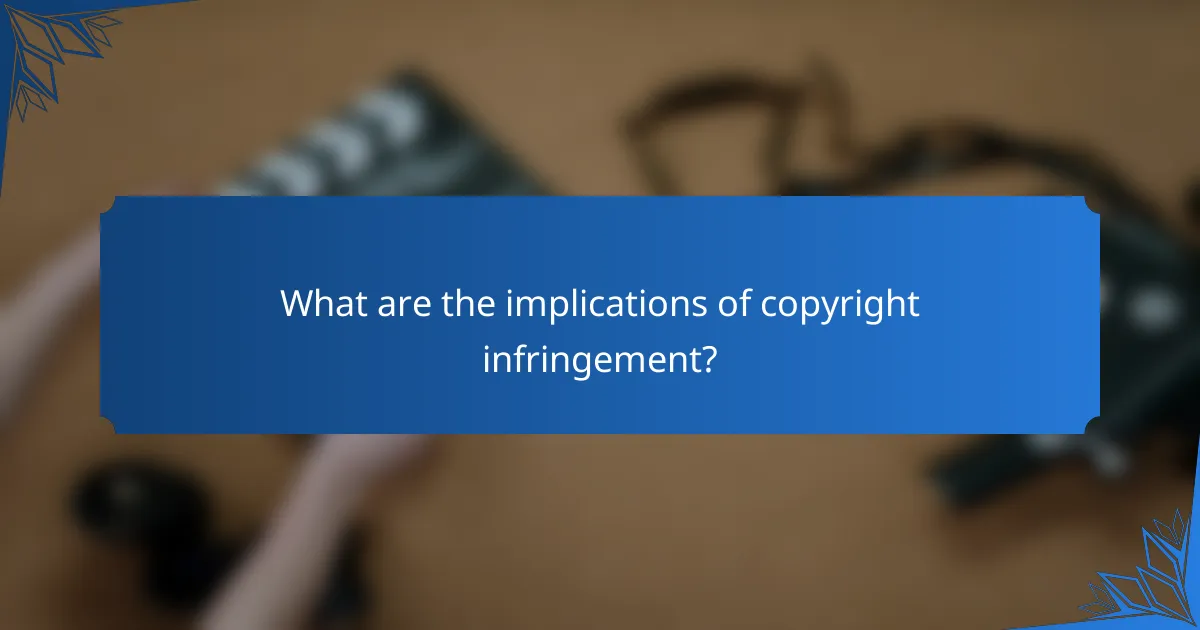
What are the implications of copyright infringement?
Copyright infringement can lead to serious legal, financial, and reputational consequences for individuals and organizations. Understanding these implications is crucial for anyone involved in the creation or distribution of copyrighted material.
Legal consequences
Engaging in copyright infringement can result in lawsuits and legal actions from the copyright holder. Courts may issue injunctions to stop the infringing activity and can require the infringer to pay for damages incurred by the copyright owner.
In some cases, especially when infringement is willful, criminal charges may be pursued, leading to fines or even imprisonment. It is essential to be aware of copyright laws and to seek permission when using protected works.
Financial penalties
Financial penalties for copyright infringement can be substantial, often ranging from hundreds to millions of dollars, depending on the severity and scale of the infringement. Statutory damages can be awarded, which may amount to thousands of dollars per work infringed.
Additionally, infringers may be liable for the copyright owner’s legal fees, further increasing the financial burden. Businesses should consider obtaining licenses or permissions to avoid these costly penalties.
Reputational damage
Copyright infringement can severely damage an individual’s or organization’s reputation. Being labeled as a copyright infringer can lead to loss of trust from clients, partners, and the public.
Reputational harm can have long-lasting effects, including decreased sales and difficulty in forming new business relationships. To protect reputation, it is advisable to respect copyright laws and maintain transparency in the use of copyrighted materials.
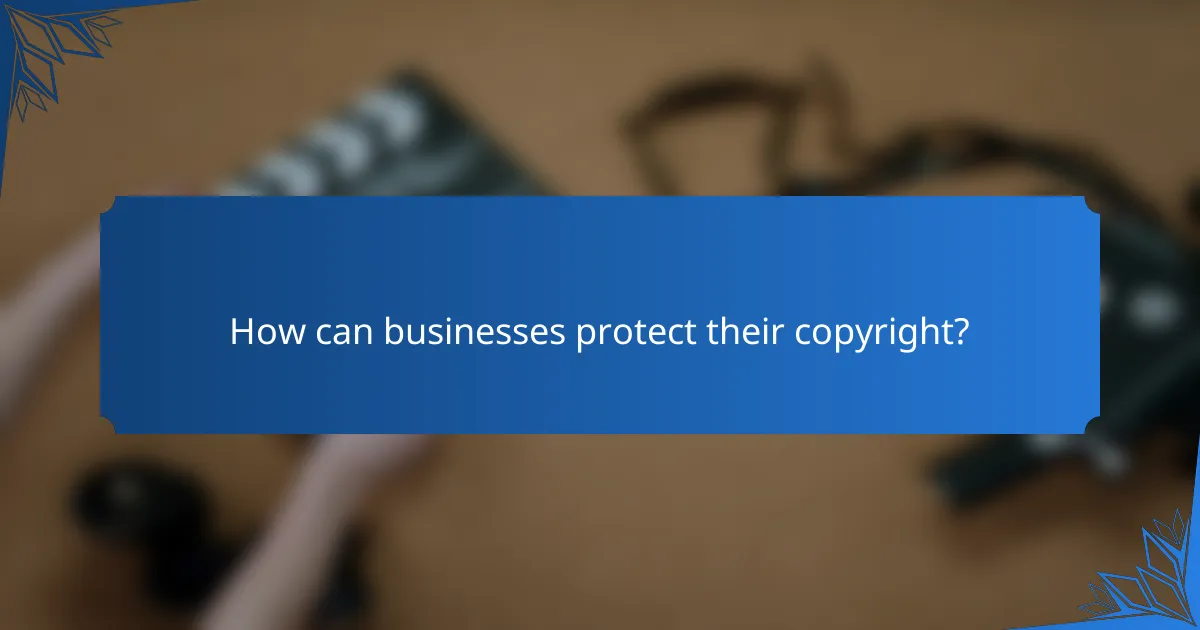
How can businesses protect their copyright?
Businesses can protect their copyright by registering their works, monitoring usage, and implementing enforcement strategies. These steps help ensure that their intellectual property is safeguarded against unauthorized use and infringement.
Registration with the US Copyright Office
Registering with the US Copyright Office provides legal advantages, including the ability to sue for statutory damages and attorney’s fees in case of infringement. The registration process involves submitting an application, a copy of the work, and a fee, which typically ranges from $35 to $55.
While registration is not mandatory, it is highly recommended for businesses that want to enforce their rights effectively. It serves as a public record of ownership, which can deter potential infringers.
Monitoring usage
Monitoring usage of copyrighted materials is crucial for identifying unauthorized use. Businesses can utilize tools and services that track where and how their content is being used online, including social media and websites.
Regularly checking for infringements allows businesses to take timely action. Setting up Google Alerts or using digital rights management (DRM) software can help in this process.
Enforcement strategies
Enforcement strategies involve taking action against copyright infringement to protect intellectual property. This can include sending cease-and-desist letters, filing takedown notices under the Digital Millennium Copyright Act (DMCA), or pursuing legal action if necessary.
Businesses should weigh the costs and benefits of enforcement actions, as litigation can be expensive. Often, a well-crafted cease-and-desist letter can resolve issues without escalating to court.
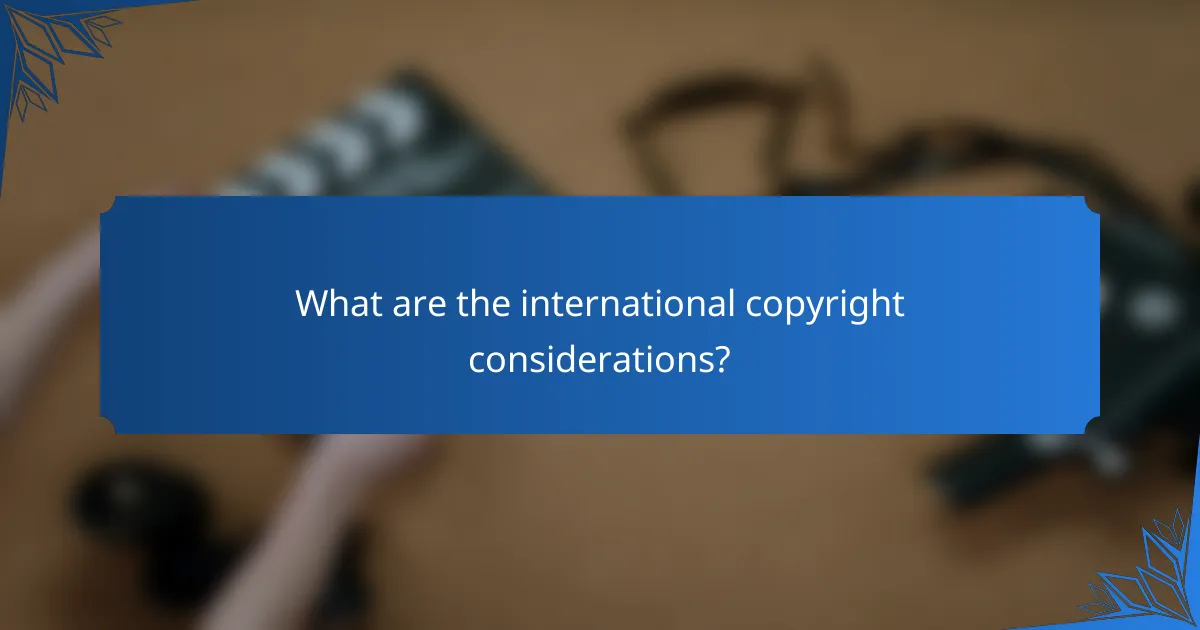
What are the international copyright considerations?
International copyright considerations involve understanding various treaties and agreements that govern the protection of creative works across borders. Key elements include the principles of copyright ownership, fair use, and licensing, which can vary significantly from one country to another.
Berne Convention
The Berne Convention is a foundational international treaty that establishes minimum standards for copyright protection among its member countries. It mandates that works created in one member country receive the same protection in all other member countries without the need for formal registration.
One critical aspect of the Berne Convention is the “automatic protection” principle, which means that copyright exists from the moment a work is created, lasting for the life of the author plus a specified number of years, typically 50 to 70 years. This ensures that creators retain rights to their works internationally.
WIPO treaties
The World Intellectual Property Organization (WIPO) administers several treaties that enhance international copyright protection, including the WIPO Copyright Treaty (WCT) and the WIPO Performances and Phonograms Treaty (WPPT). These treaties address issues such as digital rights management and the protection of performers and producers in the digital environment.
WIPO treaties encourage member countries to adopt laws that reflect modern technological advancements, ensuring that copyright holders can enforce their rights in the digital space. Countries that are party to these treaties must implement protections that align with the treaty’s provisions, which can vary in effectiveness based on local laws.
